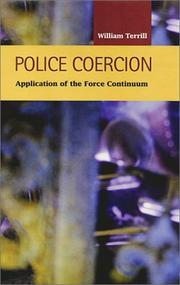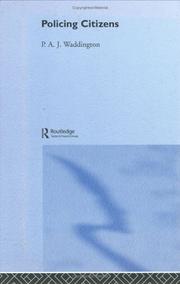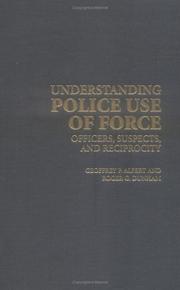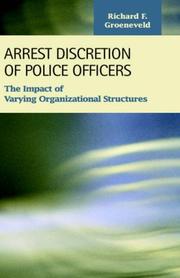| Listing 1 - 10 of 16 | << page >> |
Sort by
|
Book
ISBN: 162637788X 9781626377882 1626377553 Year: 2019 Publisher: Boulder, Colorado : Lynne Rienner Publishers, Inc.,
Abstract | Keywords | Export | Availability | Bookmark
 Loading...
Loading...Choose an application
- Reference Manager
- EndNote
- RefWorks (Direct export to RefWorks)
Depolicing—the withdrawal from proactive law enforcement by officers on the line—has become an increasing concern within both police departments and the communities that they serve. Willard Oliver, a former policeman himself, draws on extensive interviews with officers in a variety of jurisdictions to explore how prevalent depolicing has become, why officers engage in it, and what can be done to minimize it. With officer behavior under more and more intense scrutiny, Depolicing is a uniquely important contribution to ongoing debates.
Police discretion --- Police-community relations --- Police administration
Multi
ISBN: 9783031222818 9783031222801 9783031222825 Year: 2023 Publisher: Cham Springer Nature
Abstract | Keywords | Export | Availability | Bookmark
 Loading...
Loading...Choose an application
- Reference Manager
- EndNote
- RefWorks (Direct export to RefWorks)
This book gives an overview of the empirical research regarding police discretionary decision-making worldwide through 2022 by means of a scoping review. In total, eleven databases were searched and 15,193 publications have been assessed in terms of relevance for this topic, with 1,563 of these being assessed more thoroughly. The shortlist consists of 526 publications. It answers the following questions: What is the amount of available research concerning police decision-making and what are its characteristics? How and where is police decision-making studied? Which crime phenomena are studied? Which types of decisions are studied? Which factors impact police discretion? Overall, the scoping review summarizes the available empirical research on police discretion and helps understand police decision-making processes. These findings are then used to discuss the current scholarship and give recommendations concerning research (e.g. which decision-making processes/decisions are currently lacking in research, which factors need to be explored further, which research methods can be utilized more frequently) and police practice (i.e. how to support police officers in their decision-making and optimize these decision-making processes).
Science --- Criminology. Victimology --- onderzoeksmethoden --- criminologie --- criminaliteit --- Police --- Police discretion. --- Decision making.

ISBN: 193120280X 9781931202800 9781931202091 1931202095 1931202095 Year: 2001 Publisher: New York LFB Scholarly Pub. LLC
Abstract | Keywords | Export | Availability | Bookmark
 Loading...
Loading...Choose an application
- Reference Manager
- EndNote
- RefWorks (Direct export to RefWorks)
Police discretion --- Police brutality --- Resisting an officer --- Police-community relations --- Discretion, Police --- Administrative discretion --- Officer, Resisting an --- Crime

ISBN: 1135361509 1280186623 0203501632 9786610186624 9781135361501 9781857286922 9781857286939 9780203501634 9781135361457 9781135361495 1135361495 Year: 2014 Publisher: London
Abstract | Keywords | Export | Availability | Bookmark
 Loading...
Loading...Choose an application
- Reference Manager
- EndNote
- RefWorks (Direct export to RefWorks)
This comparative text serves both as an introduction to contemporary police studies and an intervention into current debates concerning police reform and practice.
Police power. --- Police discretion. --- Discretion, Police --- Administrative discretion --- Administrative law --- Constitutional law --- Municipal corporations --- Political science --- Right of property
Book
ISBN: 1479890340 Year: 2016 Publisher: New York, NY : New York University Press,
Abstract | Keywords | Export | Availability | Bookmark
 Loading...
Loading...Choose an application
- Reference Manager
- EndNote
- RefWorks (Direct export to RefWorks)
Winner, 2019 Outstanding Book Award, given by the American Society of Criminology’s Division of Policing Section The first in-depth history and analysis of a much-abused policing policy No policing tactic has been more controversial than “stop and frisk,” whereby police officers stop, question and frisk ordinary citizens, who they may view as potential suspects, on the streets. As Michael White and Hank Fradella show in Stop and Frisk, the first authoritative history and analysis of this tactic, there is a disconnect between our everyday understanding and the historical and legal foundations for this policing strategy. First ruled constitutional in 1968, stop and frisk would go on to become a central tactic of modern day policing, particularly by the New York City Police Department. By 2011 the NYPD recorded 685,000 ‘stop-question-and-frisk’ interactions with citizens; yet, in 2013, a landmark decision ruled that the police had over- and mis-used this tactic. Stop and Frisk tells the story of how and why this happened, and offers ways that police departments can better serve their citizens. They also offer a convincing argument that stop and frisk did not contribute as greatly to the drop in New York’s crime rates as many proponents, like former NYPD Police Commissioner Ray Kelly and Mayor Michael Bloomberg, have argued. While much of the book focuses on the NYPD’s use of stop and frisk, examples are also shown from police departments around the country, including Philadelphia, Baltimore, Chicago, Newark and Detroit. White and Fradella argue that not only does stop and frisk have a legal place in 21st-century policing but also that it can be judiciously used to help deter crime in a way that respects the rights and needs of citizens. They also offer insight into the history of racial injustice that has all too often been a feature of American policing’s history and propose concrete strategies that every police department can follow to improve the way they police. A hard-hitting yet nuanced analysis, Stop and Frisk shows how the tactic can be a just act of policing and, in turn, shows how to police in the best interest of citizens.
Racial profiling in law enforcement --- Police discretion --- Stop and frisk (Law enforcement) --- Law and legislation --- New York (State) --- United States.
Book
ISBN: 9781479890347 1479890340 9781479835881 1479835889 Year: 2016 Publisher: New York, NY
Abstract | Keywords | Export | Availability | Bookmark
 Loading...
Loading...Choose an application
- Reference Manager
- EndNote
- RefWorks (Direct export to RefWorks)
Winner, 2019 Outstanding Book Award, given by the American Society of Criminology’s Division of Policing Section The first in-depth history and analysis of a much-abused policing policy No policing tactic has been more controversial than “stop and frisk,” whereby police officers stop, question and frisk ordinary citizens, who they may view as potential suspects, on the streets. As Michael White and Hank Fradella show in Stop and Frisk, the first authoritative history and analysis of this tactic, there is a disconnect between our everyday understanding and the historical and legal foundations for this policing strategy. First ruled constitutional in 1968, stop and frisk would go on to become a central tactic of modern day policing, particularly by the New York City Police Department. By 2011 the NYPD recorded 685,000 ‘stop-question-and-frisk’ interactions with citizens; yet, in 2013, a landmark decision ruled that the police had over- and mis-used this tactic. Stop and Frisk tells the story of how and why this happened, and offers ways that police departments can better serve their citizens. They also offer a convincing argument that stop and frisk did not contribute as greatly to the drop in New York’s crime rates as many proponents, like former NYPD Police Commissioner Ray Kelly and Mayor Michael Bloomberg, have argued. While much of the book focuses on the NYPD’s use of stop and frisk, examples are also shown from police departments around the country, including Philadelphia, Baltimore, Chicago, Newark and Detroit. White and Fradella argue that not only does stop and frisk have a legal place in 21st-century policing but also that it can be judiciously used to help deter crime in a way that respects the rights and needs of citizens. They also offer insight into the history of racial injustice that has all too often been a feature of American policing’s history and propose concrete strategies that every police department can follow to improve the way they police. A hard-hitting yet nuanced analysis, Stop and Frisk shows how the tactic can be a just act of policing and, in turn, shows how to police in the best interest of citizens.
Racial profiling in law enforcement --- Police discretion --- Stop and frisk (Law enforcement) --- Law and legislation --- New York (State) --- United States.
Book
ISBN: 0773417370 9780773417373 9780773436640 0773436642 Year: 2010 Publisher: Lewiston The Edwin Mellen Press
Abstract | Keywords | Export | Availability | Bookmark
 Loading...
Loading...Choose an application
- Reference Manager
- EndNote
- RefWorks (Direct export to RefWorks)
Using data from systematic social observations of police-citizen encounters, the statistical analyses demonstrate the importance of understanding the dynamics of police citizen encounters. The findings suggest how to enhance police legitimacy and improve the experiences of police citizen interactions. This book will appeal to criminal justice scholars and practitioners.
Interpersonal relations. --- Police discretion. --- Police etiquette. --- Police. --- Police-community relations. --- Police-community relations --- Police discretion --- Police etiquette --- Interpersonal relations --- Police --- Social Welfare & Social Work --- Social Sciences --- Criminology, Penology & Juvenile Delinquency --- Cops --- Gendarmes --- Law enforcement officers --- Officers, Law enforcement --- Officers, Police --- Police forces --- Police officers --- Police service --- Policemen --- Policing --- Criminal justice, Administration of --- Criminal justice personnel --- Peace officers --- Public safety --- Security systems --- Human relations --- Interpersonal relationships --- Personal relations --- Relations, Interpersonal --- Relationships, Interpersonal --- Social behavior --- Social psychology --- Object relations (Psychoanalysis) --- Etiquette --- Discretion, Police --- Administrative discretion --- Public relations --- Legal status, laws, etc.

ISBN: 0521837731 0521546753 1107161800 051126481X 0511265530 0511315910 0511499442 1280749571 051126321X 051126402X 9780511265532 0511261594 9780511261596 9780511264023 9780511264818 9780511499449 9780521837736 9781280749575 9786610749577 6610749574 9780521546751 9781107161801 9780511315916 Year: 2004 Publisher: Cambridge ; New York : Cambridge University Press,
Abstract | Keywords | Export | Availability | Bookmark
 Loading...
Loading...Choose an application
- Reference Manager
- EndNote
- RefWorks (Direct export to RefWorks)
Whenever police officers come into contact with citizens there is a chance that the encounter will digress to one in which force is used on a suspect. Fortunately, most police activities do not involve the use of force. But those that do reflect important patterns of interaction between the officer and the citizen. This book examines those patterns. It begins with a brief survey of prior research, and then goes on to present data and findings. Among the data are the force factor applied - that is, the level of force used relative to suspect resistance - and data on the sequential order of incidents of force. The authors also examine police use of force from the suspect's perspective. In analyzing this data they put forward a conceptual framework, the Authority Maintenance Theory, for examining and assessing police use of force.
Arrest (Police methods) --- Restraint of prisoners --- Police brutality --- Police discretion --- Arrestation (Mesures policières) --- Prisonniers --- Brutalités policières --- Pouvoir discrétionnaire de la police --- Immobilisation --- Arrestation (Mesures policières) --- Brutalités policières --- Pouvoir discrétionnaire de la police --- Social Sciences --- Sociology --- Physical restraint of prisoners --- Prisoner restraint --- Prison discipline --- Arresting --- Police

ISBN: 1593321813 9781593321819 9781593321253 1593321252 9781593323363 1593323360 Year: 2005 Publisher: New York : LFB Scholarly Pub.,
Abstract | Keywords | Export | Availability | Bookmark
 Loading...
Loading...Choose an application
- Reference Manager
- EndNote
- RefWorks (Direct export to RefWorks)
Police discretion --- Arrest (Police methods) --- Organizational behavior --- Police administration --- Police --- Organization --- Organizational research --- Cops --- Gendarmes --- Law enforcement officers --- Officers, Law enforcement --- Officers, Police --- Police forces --- Police officers --- Police service --- Policemen --- Policing --- Criminal justice, Administration of --- Criminal justice personnel --- Peace officers --- Public safety --- Security systems --- Arresting --- Decision making. --- Research. --- Legal status, laws, etc.
Book
ISBN: 1555538142 9781555538149 9781555538125 1555538126 9781555538132 1555538134 Year: 2013 Publisher: Boston
Abstract | Keywords | Export | Availability | Bookmark
 Loading...
Loading...Choose an application
- Reference Manager
- EndNote
- RefWorks (Direct export to RefWorks)
An inside look at police discretionary actions and their consequences for poor communities
Police --- Minorities. --- Poor. --- Police-community relations. --- Police discretion. --- Ethnic minorities --- Foreign population --- Minority groups --- Persons --- Assimilation (Sociology) --- Discrimination --- Ethnic relations --- Majorities --- Plebiscite --- Race relations --- Segregation --- Disadvantaged, Economically --- Economically disadvantaged --- Impoverished people --- Low-income people --- Pauperism --- Poor --- Poor, The --- Poor people --- Social classes --- Poverty --- Public relations --- Discretion, Police --- Administrative discretion --- Economic conditions
| Listing 1 - 10 of 16 | << page >> |
Sort by
|

 Search
Search Feedback
Feedback About UniCat
About UniCat  Help
Help News
News